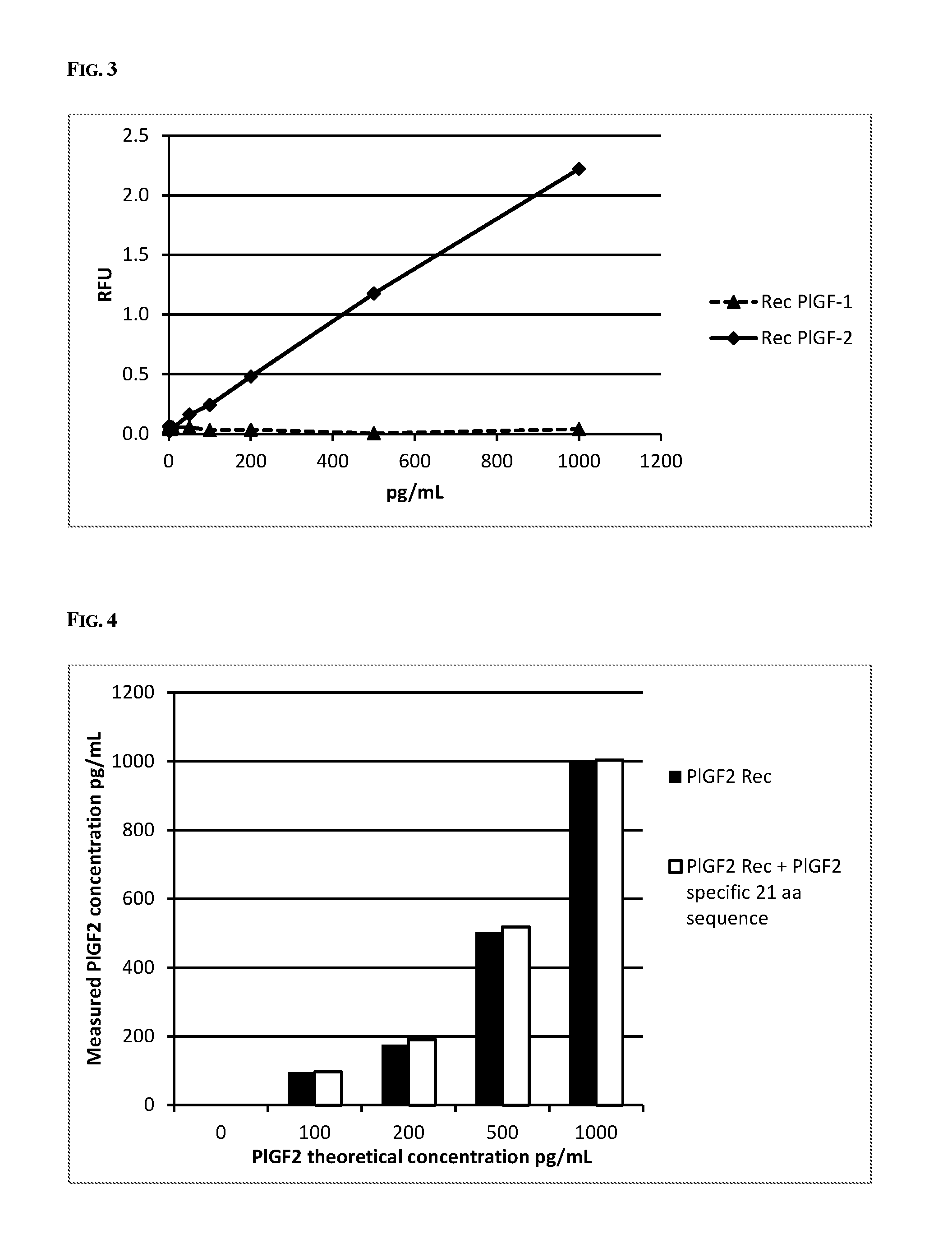Method for the selective determination of placental growth factor 2
a placental growth factor and selective determination technology, applied in the field of clinical diagnostics, can solve the problems of inability no routine screening of preeclampsia using maternal samples, and still fails to detect a significant number of down syndrome cases and other aneuploidy-affected pregnancies, so as to increase the risk of the subject or fetus, and the risk of aggr
- Summary
- Abstract
- Description
- Claims
- Application Information
AI Technical Summary
Benefits of technology
Problems solved by technology
Method used
Image
Examples
example 1
Generation of Antibodies
Polyclonal Antibody
[0102]Polyclonal antibody directed against human PlGF was commercially purchased from (R&D Systems Europe Ltd. Abingdon UK; Ref No: AF-264-PB).
Development of Monoclonal Antibodies
[0103]Monoclonal antibodies against PlGF-2 were generated by standard procedures (Harlow E, Lane D. Antibodies—A Laboratory Manual. Cold Spring Harbor: Cold Spring Harbor Laboratory, 1988; Lane 1985. Journal of Immunology Methods 81: 223-228). For the generation of anti-human PLGF-2 antibodies, 8-week-old female BALB / c mice were immunized with 50 μg human recombinant PlGF-2 (R&D Systems Europe Ltd. Abingdon UK) dissolved in 11 mmol / L sodium phosphate buffer (pH 7.2) containing 140 mmol / L NaCl. Subsequent booster injections of immunogen were administrated in 4-week intervals. The fusion was done with SP2 / 0 mouse myeloma cells (SP2 / 0-Ag 14) 3 months after initial immunization. The clones 477 / G2 and 477 / E5 were screened by ELISA with immobilized recombinant human PlGF...
example 2
Development of a PlGF-2 Assay Using Monoclonal and Polyclonal Antibodies
[0106]A homogenous sandwich fluoroimmunoassay using Time Resolved Amplified Cryptate Emission (TRACE) technology (Mathis, 1993. Clin Chem 39(9): 1953-9) was developed for the detection of PlGF-2.
[0107]The stock Lumi4®-Tb-conjugated antibody and cyanine 5.5-conjugated antibody solution were diluted at 0.125 μg / mL and 5 μg / mL with assay buffer (100 mmol / L sodium phosphate pH 7, 0.375% bovine serum albumin free protease, 0.25 mg / mL mouse IgG, 0.25 mg / mL bovine IgG, 0.25 mg / mL goat IgG), respectively, prior to use. The recombinant human PlGF-2 was diluted in defibrinated normal human plasma heat treated to give PlGF-2 standards. The immunoassay was performed by incubating 70 μL of samples / calibrators, 40 μL of cyanine 5.5-conjugated antibody solution and 40 μL of Lumi4®-Tb-conjugated antibody solution at 37° C. on B.R.A.H.M.S KRYPTOR compact PLUS instrument (Thermo Scientific B.R.A.H.M.S GmbH, Hennigsdorf / Berlin, Ge...
example 3
Dose Response Curve of the Assay with Clone 477 / G2
[0108]A dose response curve could be created by using the recombinant PlGF-2 (SEQ ID NO:3) as standard material in the monoclonal immunoassay as described above. A typical dose response curve is shown in FIG. 2.
PUM
| Property | Measurement | Unit |
|---|---|---|
| distance | aaaaa | aaaaa |
| distance | aaaaa | aaaaa |
| diastolic blood pressure | aaaaa | aaaaa |
Abstract
Description
Claims
Application Information
 Login to View More
Login to View More - R&D
- Intellectual Property
- Life Sciences
- Materials
- Tech Scout
- Unparalleled Data Quality
- Higher Quality Content
- 60% Fewer Hallucinations
Browse by: Latest US Patents, China's latest patents, Technical Efficacy Thesaurus, Application Domain, Technology Topic, Popular Technical Reports.
© 2025 PatSnap. All rights reserved.Legal|Privacy policy|Modern Slavery Act Transparency Statement|Sitemap|About US| Contact US: help@patsnap.com


